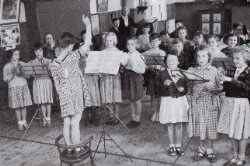ABOUT JERICHO - HISTORY
Memories of wigs and cassocks

Music class at St. Barnabas
More recollections from Jo Elvidge, now in Somerset
Posted - March 03, 1999It was heart-warming to hear from friends who remember 'Josie Rumble' following my 'Jericho Childhood' article (May 1998). Eric Clarke kindly sent me a school photograph, probably circa 1932. Sadly, Eric says that many of the boys lost their lives in the War, and others have died since. Some teachers leave a lasting memory, for good or ill, and infant-school days were coloured by green hammocks, in which we took our rest, and by Miss Johnson of the Reception Class, a lady with a severe chignon hair style, and later on, by Miss Coles, who inspired a fearful respect, and who we imagined wore an auburn wig.
As St. Barnabas was a church school, Canon Bisdee came to take Scripture lessons. In his black cassock and biretta he seemed remote and austere; and the Church itself was dark and forbidding. The Senior School Headmaster was Mr. Miles, a white-haired bachelor, who sometimes forayed with pupils to unlock the secrets of our famous city. I once won half-a-crown for an essay written after a visit to the Sheldonian Theatre and the Bodleian Library, because I mentioned their 'Corinthian and Ionic pillars'.
With music in the family, my parents struggled to buy me a piano, paying weekly by instalments, and I took lessons for sixpence a week with Miss Pratley in Cranham Terrace. She was a strict Victorian lady, who wielded a heavy pointer and lifted one's wrists to the correct angle. The piano, of course, needed tuning from time to time, and that introduced us to Oscar, a blind man, well-known in the area. Hedges, the Butcher (now Ali's), had a shop on the corner of Albert and Gt. Clarendon Streets, and most weekends I was dispatched to ask for 'the blade end of a half-shoulder of lamb, please'.
Phyllis Hedges, the daughter, once took me to the family farm in Temple Cowley to savour the delights of 'almost country' as Cowley was then. Of course we also had the freedom of Port Meadow when we were old enough to fish for tiddlers and collect frog-spawn at Medley, passing a Catholic Seminary at the top of Walton Well Road, where we sometimes stopped to be shown the aviary by the Brothers. The friends who most influenced my life were those at Walton St. Methodist Church, since demolished (like my home in Wellington St). I am indebted to them for introducing me to art and literature, to summer plays in College Gardens, to boating on the Cherwell, and to the wider world of learning, in short, to the treasures of Oxford - 'my city'.
Author: Jo Elvidge
Why Jericho still has such a mix of houses?
Jericho's intriguing mix of housing today owes a lot, to the Residents' Association in the 1960s and 1970s which together with the then Vicar and some local councillors resisted plans to bulldoze the whole area and turn it over to offices and light industrial use.
Who has a car?
According to the 2001 Census, only 47% of Jericho households have a car compared with 67% for Oxford as a whole.